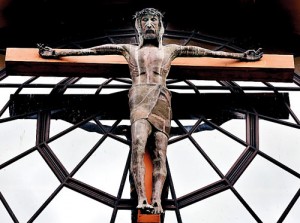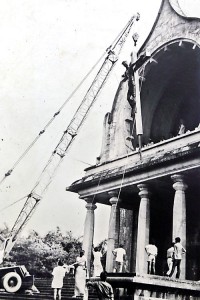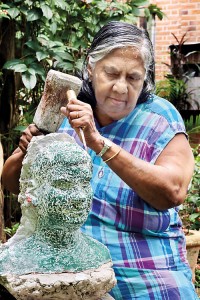The woman behind the ‘Dying Christ’
Kandyan saree and all, each day she would clamber agilely up the high scaffolding in her sprawling garden off Boyd Place, Kollupitiya, to attend to every tiny detail herself, while her husband would stand below and shout out advice based on photographs in his hands.
How many of those who still gaze in prayerful wonder at the huge bronze figure of the ‘Dying Christ’ at the Tewatte Basilica in Ragama would link this artistic endeavour to Leela Peries, now 76 and widowed, but still living down Boyd Place.

‘Dying Christ’ at Tewatte: For the devotees to see Pix by M.A. Pushpa Kumara
It is on a lazy Monday afternoon after the school rush is over, as Bishop’s College is just up the road, that we meet Leela, the sculptress, to find out what made her undertake this huge work of art – the bronze figure of 12’4” which at the time of its installation, back in 1977, was saluted by newspapers as “enrapturing the heart”.
It was just the 12th Station of the Cross that the Catholic Church wanted Leela to sculpt for Tewatte. But it finally became a “big commissioning” that she got quite accidentally. (The Stations of the Cross are events during Jesus Christ’s agonised journey up Mount Calvary after being condemned to be crucified, replicated in many churches.)
Sculpture not being the only love of her life but Leela also being a passionate wildlife enthusiast, she was bird-watching at the Embilipitiya farm of the River Valleys’ Development Board when introduced to well-known engineer Don Wilfred Richard

A labour of love: Leela adding the finishing touches to the ‘Dying Christ’ in 1977
Kahawita. Later he “summoned” the young sculptress to meet him in Colombo, with the proposition that she should make the 12th Station of the Cross above the facade of the Tewatte Basilica.
The Basilica too had a tale attached, going back to the time of World War II, when it was no big building but a small church, with a French priest in charge. As the Japanese Army, on the warpath, made its inexorable way forward, capturing Burma, the priest knelt in prayer to make a vow. If Ceylon was spared of a Japanese invasion, he promised, in place of the Ragama church would rise a magnificent Basilica.
“We were spared,” says Leela, and it was as a fulfilment of the vow that architects had been deployed soon after by the Catholic Church to build the Basilica.

Installation in 1977: The ‘Dying Christ’ being put in place at Tewatte under the watchful eyes of Leela
It was much later in the 1970s that Leela was in Dr. Kahawita’s office looking at the plans of the Basilica’s facade spread on the table. “But the area was enormous,” she says and it was then that she suggested that the cross should be 21’ to be in proportion with the arch and the statue of Christ double life-size. Dr. Kahawita readily agreed.
However, she was assailed by doubts. Being an Anglican and with ‘Thou shalt make no graven images’ seared into her memory, she needed guidance. Gently, Cardinal Thomas Cooray led her along the path to enlightenment by pointing out that what was important for worshippers was to concentrate on prayer while looking at a statue. “Therefore, I’d like you to work on the Turin Shroud to capture the image of Christ,” he told her handing over two photographs – one of the whole of the shroud and the other of the face on the shroud.
He also described to her the agony and humiliation that Christ went through in his final hours of bearing the cross. “He (Cardinal Thomas Cooray) was so accurate and went into such detail that it seemed as if he himself had endured the agony,” remembers Leela with poignancy.
It was then that Leela took up the endeavour – building a shed “in this very garden”, making an armature (skeleton) of metal rods on which she piled on clay and got the figure right.
It was such a big thing that she worked on scaffolding, while her husband, Christopher Edward Peries, a devout Catholic, was extremely helpful looking at the photographs given by Cardinal Cooray and telling her where to reduce the clay or put more. “I was seeing one foot before my eyes, while he had the whole view,” she says.
Before we discuss the completion of the sculpture of the ‘Dying Christ’, we take a walk back into Leela’s childhood. Schooling was at Girls’ High School, Mount Lavinia, and Bishop’s College, Colombo, and classes to nurture her creativity, at the Melbourne Art Classes of reputed Cora

Still into bronze: Leela at work today
Abraham. The family living in Mount Lavinia moved to their small estate in Kadugannawa when the colonial government, embroiled in World War II with the Japanese, acquired their home in Mount Lavinia, for nurses’ quarters, but later returned after the war.
The Cora Abraham classes brought out a latent talent, while the other children dabbled in colours, what attracted Leela was form.
Just after turning 20, Leela headed across the seas to southeast England and two years of extensive study in the Sculpture Department of the Camberwell School of Art, with her main tutor being Dr. Vogel, a Czechoslovakian Jew who had fled the Holocaust. Twelve of the students were from Britain and the others from Germany, America and South Africa and only Leela from the east.
Pretty intensive, recalls Leela of her studies. Creative work was from 9 a.m. to 2 p.m., including the study of the human body looking at nude models in the studio. Lectures on the history of art followed in the afternoon, while from 6 to 9 p.m. it was training in the technical aspects of casting sculpture in plaster of Paris, terracotta and bronze under the eye of professionals from well-known companies.
Digressing how she may have developed a fondness for nature, she reminisces how with the extended family on her mother’s (Irene de Silva) side, such as Sam Elapatha Disawa and Arthur Molamure – who had been involved in elephant kraals – they went camping along the Menik Ganga in Yala every December. Joining them were many European friends on the Wildlife and Nature Protection Society (WNPS) committee including Ted Norris who was President and his wife, Patsy, and other planters from Namunukula.
Her involvement in the WNPS deepened when committed conservationist Thilo Hoffmann took over as its President and they had high profile members such as McNeil and Christine Wilson, well-known surgeon Dr. Drogo Austin, C.P. de Silva, Lalith Senanayake and Queen’s Counsel E.B. Wikramanayake. It was during this time that the WNPS was able to get Uda Walawe declared as a National Park and save the Sinharaja rainforest from the menace of logging.
The first big project, meanwhile, in her chosen profession was to sculpt a life-size bronze of Rev. Soratha for the Vidyodaya University which she undertook with a friend, Ann Whipp, who was visiting from England.
Later she married Christopher, having met him in 1963 but “not falling in love at first sight”, but gradually getting to know him, after being introduced at the home of cousin, James Obeyesekera.
We then pick up the threads of how Leela sculpted the ‘Dying Christ’. After the clay positive she used plaster of Paris to get a negative of the figure, with the latter being taken out section by section later and cleaned with water and soft soap. Next was the waxing stage, painting beeswax into the plaster negative to the thickness that she wanted the bronze to ultimately be. Thereafter, another mould was made around the wax and the original plaster chipped away. This wax positive was attached to a wax cup with runners and air-vents. When the moulds were burnt in a kiln, the wax melted away leaving a hollow. These moulds were then placed in a pit near the furnace and clean metal — melted in a crucible with chemicals being added to clean it — poured into the moulds and allowed to cool. Many hours later, the moulds were dug out of the pit and the plaster broken with a wooden mallet, uncovering the bronze with the runners and the air-vents.
“The crucible I had could only hold 100 pounds of metal,” she says, explaining in detail how she poured the metal, section by section, to 46 sections in all. Three and a half years it took her, holding her focus entirely.
The metal sections then got a sulphuric acid bath, after which the runners and air-vents were cut off, the metal cleaned with a wire-brush and the sections welded together to make the whole statue. Heated up with a blow-lamp, a chemical was applied to give a patina (a uniform colour), touched up with a light coat of wax and wiped down with a soft cloth.
By 1977 the statue was complete. “It was so big that it couldn’t be taken out of our gate but had to be carried over the wall and placed on a flat-bed lorry for the journey to Tewatte, to be fixed for the faithful to see.
Many years later, when Leela re-visited the Basilica, she was aghast to find that the statue had been tarred over by an over-enthusiastic priest. “The soul of the statue was gone,” she says, recalling her sorrow.
Hurrying to St. Anthony’s Church, Kochchikade, she “prayed and prayed”. A few days later she dreamt of being in a concrete building, with a staircase leading up. Someone, taller than she was, wearing a robe stood to her left. She was not able to see the face, but the biscuit-coloured robe was of coarse material. Climbing the stairs, the person turned towards her and raising his hand in the sign of the cross said: “Live within Me as I live within my Father – You fool.”
Waking up soon after she wrote down the very words of her dream in her diary and at the first light of dawn rushed to the Anglican Vicarage close by and asked Fr. Duleep de Chickera what it meant. He told her that “it’s a calling. Something the Lord wants you to do”.
About five days later, Leela received a letter by post from Archbishop Nicholas Marcus Fernando with a request to visit Tewatte to “help redeem the Redeemer”. When she went back to the Basilica with her husband there was that very room of her dreams, with a staircase leading up and a globe fixed behind the huge statue of Christ, her creation. The single panel on the globe gave access to the statue.
Getting down to business, Leela was able to deploy some workers to put up a scaffolding on the top of the ledge and clean the statue right down to the metal with sulphuric acid and re-patinate (warm the statue with a blow-lamp and apply chemicals) it. Now gradually, the colour is maturing again, she says.
It was on an earlier trip — soon after the statue-installation — to the Basilica with Christopher at noon when the churchyard was deserted that she realised the impact of the ‘Dying Christ’. As Leela lingered, a woman knelt on the ground and looking up at the statue stretched out her hands in fervent prayer.
Many other statues have followed since then – one in memory of her parents she sculpted for the Church of the Ascension in Matara, another for St. Anthony’s Church, Kollupitiya, along with portraits and non-religious small bronzes. The little bronzes that she still indulges in are snapped up by a friend who exhibits and sells them at her Fine Art Gallery in Malaysia.
But the bronze which is her “life’s work” and closest to her heart, done with the support of her beloved Christopher, is the one towering above Tewatte – the enduring and heart-rending ‘Dying Christ’.


